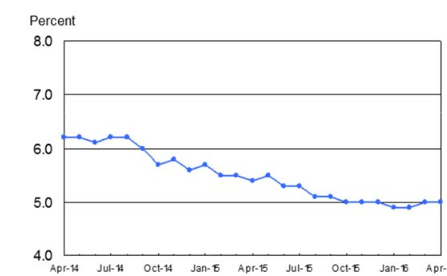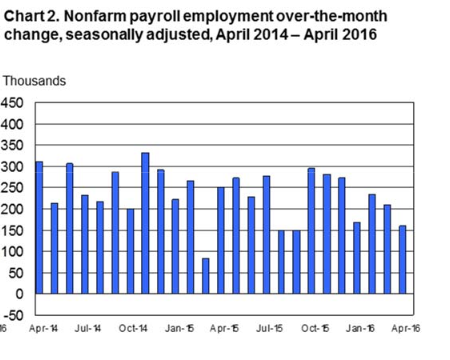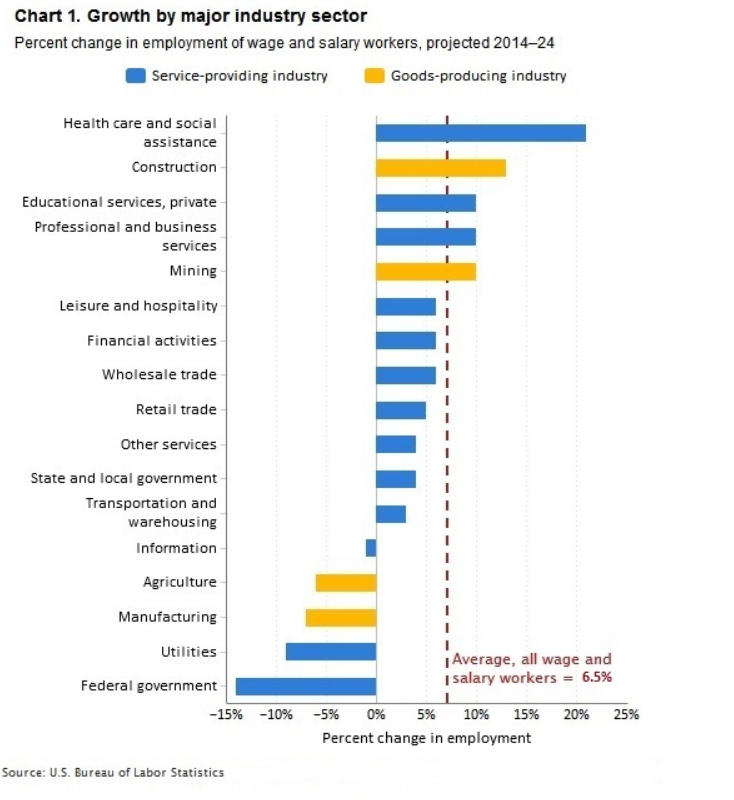Employment Blog May 2016
This employment report is from the U S Labor Department Bureau of Labor Statistics. Nonfarm payroll employment rose by 160,000 in April, and the unemployment rate was unchanged at 5.0 percent. Job gains occurred in professional and business services, health care, and financial activities, while mining employment continued to decline. This is summarized in Charts 1 and 2 below.
Incorporating revisions for February and March, which reduced nonfarm payroll employment by 19,000, monthly job gains have averaged 200,000 over the past 3 months. In the 12 months prior to April, employment growth averaged 232,000 per month.
Employment in professional and business services rose by 65,000 in April, with a large job gain in management and technical consulting services (+21,000). Professional and business services employment has risen by 611,000 over the year.
Health care employment continued to grow, with an increase of 44,000 in April. Hospitals added 23,000 jobs over the month, and ambulatory health care services added 19,000 jobs. Employment in health care increased by 502,000 over the year.
Financial activities employment rose by 20,000 in April. Credit intermediation and related activities added 8,000 jobs over the month. Employment in financial activities increased by 160,000 over the year. In April, employment changed little in retail trade (-3,000). Monthly job growth averaged 53,000 over the prior 3 months.
Employment in construction was essentially unchanged in April (+1,000), after rising by 41,000 in March. The average gain over the 2 months is in line with recent job growth in the industry.
Manufacturing employment changed little in April (+4,000), after losing 45,000 jobs over the prior 2 months. Mining employment continued to decline in April (-7,000). The industry has lost 191,000 jobs since a recent peak in September 2014. More than three-fourths of the job losses over this period have been in support activities for mining.
Average hourly earnings of all employees on private nonfarm payrolls rose by 8 cents in April to $25.53. Over the past 12 months, average hourly earnings have risen by 2.5 percent. From March 2015 to March 2016, the Consumer Price Index for All Urban Consumers (CPI-U) increased by 0.9 percent (on a seasonally adjusted basis).
Turning now to data from our survey of households, there were 7.9 million unemployed persons in April, and the unemployment rate remained at 5.0 percent. There has been little change in either measure since August. The number of long-term unemployed—those who had been looking for work for 27 weeks or more—declined to 2.1 million over the month. These individuals accounted for 25.7 percent of the unemployed. The labor force participation rate declined to 62.8 percent in April, and the employment-population ratio edged down to 59.7 percent. Among the employed, the number working part time for economic reasons, also referred to as involuntary part-time workers, was 6.0 million in April. This measure has shown little movement since November. (Involuntary part-time workers are those who would have preferred full-time employment but were working part time because their hours had been cut back or because they were unable to find full-time work.) Among people who were neither working nor looking for work in April, 1.7 million were classified as marginally attached to the labor force, down by 400,000 from a year earlier. The number of discouraged workers, a subset of the marginally attached who believed that no jobs were available for them, was 568,000 in April, down by 188,000 from a year earlier. (The marginally attached are individuals who had not looked for work in the 4 weeks prior to the survey but wanted a job, were available for work, and had looked for a job within the last 12 months.)
Healthcare occupations and industries are expected to have the fastest employment growth and to add the most jobs between 2014 and 2024, the U.S. Bureauof Labor Statistics reported today. With the increase in the proportion of the population in older age groups, more people in the labor force will be entering prime retirement age. As a result, the labor force participation rate is projected to decrease and labor force growth to slow. This slowdown of labor force growth is expected, in turn, to lead to Gross Domestic Product (GDP) growth of 2.2 percent annually over the decade. This economic growth is projected to generate 9.8 million new jobs —a 6.5-percent increase between 2014 and 2024. These projections are detailed below in Chart 1.


